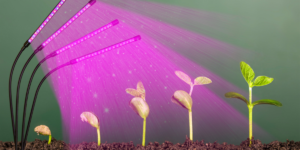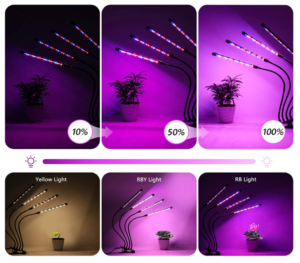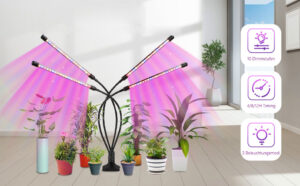You’ve probably heard that being in the presence of plants can have great benefits towards mental health. Unfortunately, most people have mixed success with growing and maintaining healthy plants in their homes.
Forgetting to water the plants and not getting adequate sunlight in the home are the two most common reasons for why a lot of people struggle to keep their plants alive inside. While the first reason is simply a matter of commitment, the second reason can actually be solved with the purchase of a plant light.
Plant lights will not only ensure healthy growth of your plants year-round, they can also be used to control their growth and life cycle. But buying a plant light requires a bit of an understanding about how plants interact with artificial light and what options are available.
To help you out, we’ve compounded all the necessary information you need to know about plant lights and how to grow plants with plant lights if you’re looking to get going on growing greener and happier flora indoors.
When it comes to choosing a light source for your plants you have three options: incandescent, fluorescent, and LED. The best light for growing plants is by far LED - they are slightly more expensive, but they meet all the plant light requirements: they have the best light spectrum output, the longest lifespan, and are the most energy-efficient.
Incandescent can also be a good option for growing plants; however, they tend to emit a significant amount of heat after a few minutes of use and that can be really bad for your plants. The advantage to using incandescent lights is that they can help you grow plants that require higher temperatures in winter time, when your home is typically a bit cooler. Just remember not to let the light bulb get too close to the plant or else it can burn the leaves and potentially kill the plant.
Fluorescent lights are cheap, energy-efficient, and don’t get as hot as incandescent lights, but they don’t have as great a light spectrum as LED or incandescent.
So, at the end of the day, it's best to go with LED lights because they will save you the most money in the long run and deliver the best quality of non-natural light to your plants. That being said, in order to ensure healthy and abundant plant growth, you’ll want to make sure you get full spectrum LED grow lights with adjustable settings for intensity, color, and timing.

We mentioned adjustable plant light color, but what does plant light color mean and how does it affect plants? Plants are receptive to all forms of light but most plants can be more or less receptive to different colors of light at certain points in their life cycles. In nature, plants’ growth cycles are dictated by the light color and color temperature of the sun which varies throughout the seasons, from red to violet light and from 2500 to 7000 Kelvin.
You can recreate this variation indoors by using adjustable color grow lights and get much better results from your plants than you would by just using regular light bulbs. It should be noted that you won’t need to worry about the effects of different light colors and color temperatures, but if you’re growing anything that flowers or fruits, you’ll want to have some idea about the plant light absorption spectrum.
The plant light absorption spectrum is the measurement of how effectively plants can turn different colors of light into food through the process of photosynthesis. Different colors of light have different wavelengths, the shorter the wavelength, the more energy it can provide to the plant.
Violet light has the shortest wavelengths and a plant light color temperature of 5000 to 7000 Kelvin; therefore, it can provide the most “food” to your plant out of any other color; red is on the opposite end of the spectrum and has the longest wavelengths and a plant light color temperature of 3500 to 4500 Kelvin, so it doesn’t provide as much energy to the plant. Green light is the exception to this rule because, although green light has short wavelengths and a high color temperature, it is not absorbed well by plants due to them being green as well.
You can use the plant light color spectrum to your advantage by adjusting the color setting on your grow lights to get better results from your plants. For example, plants tend to like violet to blue light for the vegetative stage because they need more energy to grow. If you give your plant more violet or blue light during this stage, it will grow a healthier stem and leaves than it would if it were receiving another color of light.
If you want to promote an earlier flowering stage, most plants tend to respond well to red combined with blue light as they are mostly finished growing at that point and require less energy. If you really want to play botanist, you can actually manually force your plant into flowering simply by switching from blue to red light, so long as the plant is mature enough.
This is why it is advantageous to invest in a plant light with adjustable light color settings as you can enhance or manipulate the growth of your plant depending on what stage it is at in its life cycle. However, plant growth isn’t totally decided by the color of the light, it can also be influenced by the distance of the light from the plant.

How far should I keep my grow light from my plants? As a general rule of thumb, you’ll want to keep your plant light at least 15 inches away if you’re using LED, 12 inches away if you’re using fluorescent, and 14 inches away if you’re using incandescent or HID.
That said, the distance you should keep between your plant and plant light depends on your plant light intensity and the type of plants you’re growing.
Since we’ve already established that LED is the best light source to use for growing plants indoors, we will use LED for reference. LED plant lights are considered to have high plant light intensity because of their relatively high light spectrum output which can damage or even bleach some plants. You’ll want to keep your light a fair distance away from your plants’ canopy, but this also depends on your LED plant light intensity, which can be discerned by its wattage.
Here is a general guide to how far you should keep your LED grow light from your plants based on your lights’ wattage.
19-90w – 15” away from plants
240-400w – 16-30” away from plants
450-550w – 20-30” away from plants
600-850w – 24-26” away from plants
900w+ – 26-42” away from plants
So now that we’ve covered the 3 main types of artificial light sources for growing plants indoors and how plants respond to the light spectrum; let’s go over the different ways you can deliver light to your plants.
This is often the best option for people whose homes get limited sunlight and just want a few plants to decorate or help keep the air fresh. Exposing your plants to 4-6 hours of light from a regular LED lamp will keep your plants alive and happy all year-round.
Grow lamps are usually lightweight and have highly adjustable gooseneck lamp heads which allow you to easily manoeuvre the light so that your plants can photosynthesize however and wherever you want them to. Even the real gung-ho home botanists can typically rely on just one lamp to feed all their plants as they can simply move it around their house to where they’ve placed their greens.
These grow lamps come in all sizes, from small single headed 5”x 2” desktop lamps to multi-head tripod lamps. You can use a smaller desktop version in your kitchen to grow garden herbs like rosemary, basil, sage, and mint; or even fragrant flowers like jasmine, gardenia or lavender. The larger sized grow lamps have wide radiuses so you can provide multiple plants ample light at the same time, or dedicate it to bigger more energy-consuming fruiting plants.
Regardless of which type of grow light you use for your plants, the way in which you apply the light will be the same. It all depends on what exactly you’d like to grow as all plant varieties have different light requirements. Not sure how to get started? Here is a brief rundown on how to grow houseplants, herbs, flowers, and peppers with plant lights at home.
Some of the best and easiest plants to grow at home are English ivies, Chinese evergreen, peace lilies, and maidenhair ferns. These plants can not only add some life to your home and give it a much more natural and earthy atmosphere, but they’re also very easy to take care of and respond very well to plant lights. These plants actually don’t require much light but it certainly helps if you expose them to an LED plant lamp for a couple of hours a day, especially if you like climbing plants, like pothos, and want to expedite their lush and beautiful creeping.
Fresh herbs can be expensive and will wither just a few days after taking them home from the supermarket. Fortunately, it’s really easy to grow herbs like rosemary, basil, thyme, or even chives in your kitchen where you can conveniently snip them and add them to a dish or drink. Herbs not only add freshness to your food; they also help to keep mosquitoes away and the air clean and fragrant. However, if you don’t get enough sunlight in your kitchen or you live in a region with long dark winters, you won’t be able to grow herbs very well, if at all. With the help of a grow lamp, you can have fresh garden herbs all year round. Simply allow your herbs to sit under the light for at least 6 hours per day and you’ll have a bounty of fresh, fragrant herbs ready at your disposal for your meals or to add to water or tea.
Do you love the look and smell of fresh flowers but can’t stand waiting for the better part of a year to have them? Have your own spring season in your home by getting some flower seeds and a grow light. A plant’s life cycle is largely dependent on the light color spectrum of the sun that varies from season to season. By using a plant light with a full light spectrum and adjustable color settings, you can manipulate the light that your plants receive and control their flowering cycle so you can have fresh blooms at any time of the year.
Once the seeds have successfully germinated and have sprouted their first set of true leaves, you can adjust your plant light to the blue light setting to help with the vegetative stage of the plant and ensure the healthy development of the stem and leaves. You can then switch your light to the red light setting to encourage the plant to begin flowering. Different flowers have different needs and requirements, but some of the easiest flowers to grow indoors include peace lilies, geraniums, kalanchoe, African violets, and many more.
If you’re looking to up your indoor gardening game and want to add a little heat to your home, why not try growing hot peppers? Much like growing flowers indoors, you can have great control over how your pepper plant grows by manipulating the light color settings depending on the stage of life the plant is in. Peppers typically like a lot of light, around 6-10 hours for most varieties, and some kinds can grow quite tall so you’ll need to keep a constant eye on the distance between the plant and the grow light and make adjustments as necessary.
Most fruiting plants, like peppers, require a bit more gardening know-how, such as knowledge of soil types and plant nutrition, so make sure you do your research on the other environmental requirements of the particular pepper you want to grow.
Some of the most beginner-friendly pepper varieties to grow indoors with a grow light include chiltepins, pequin peppers (be careful, these are super hot), and the Thai bird’s eye chili.
That concludes our introduction to shopping for plant lights. In some ways, it can seem daunting as there’s so much talk online about color temperatures and light spectrums and such, but for your average plant parent, you don’t need to worry about all that, you just need a basic LED light source to get the best result from your indoor plants. A good place to start would be checking out Tasmor’s tripod plant light that is great for both beginner and advanced growers.

You must be logged in to post a comment.